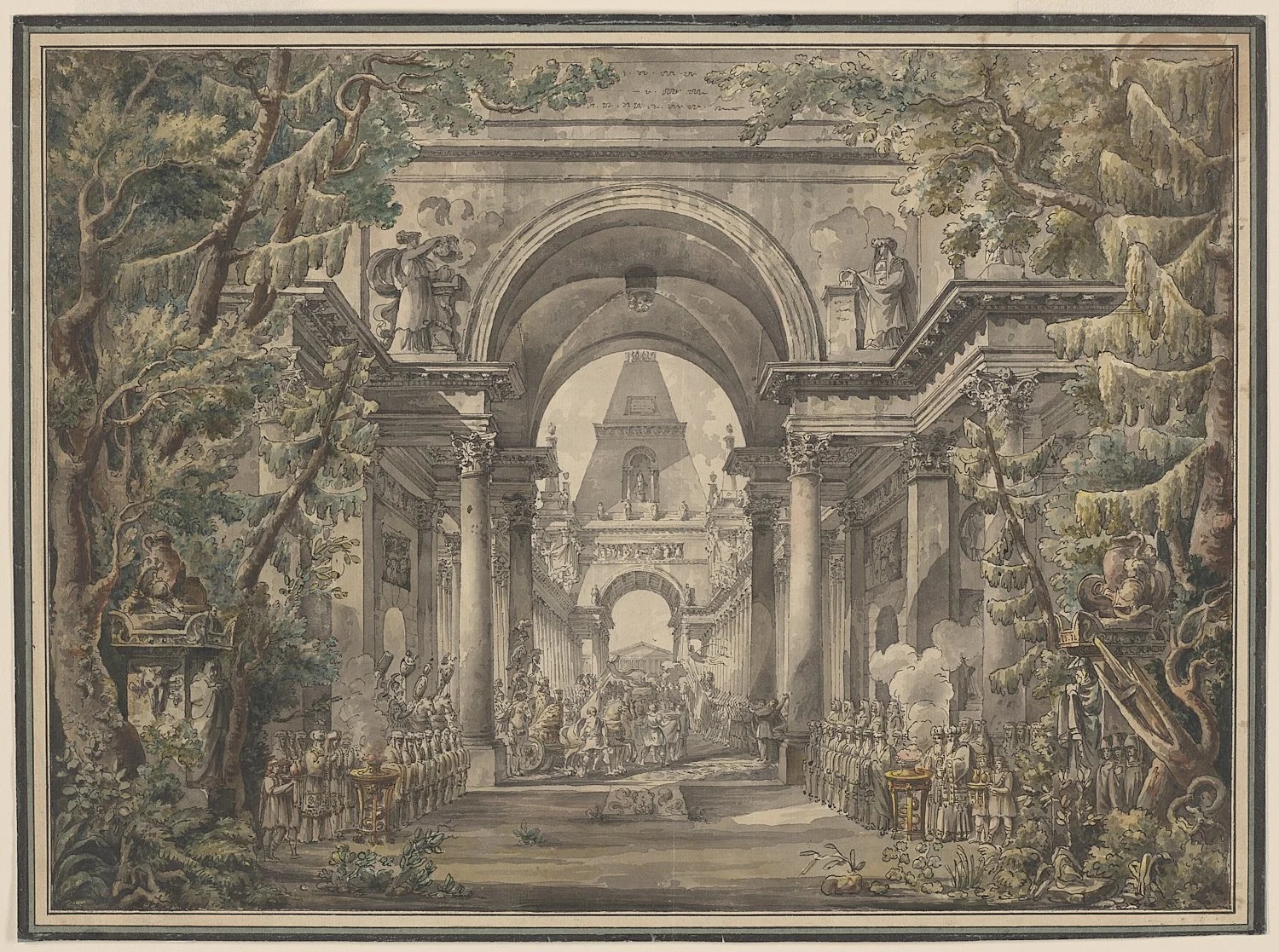Drawing of the Month #22
Wednesday, 2 July 2025. Newsletter 22.
Louis Jean Desprez (1743–1804)
The Tomb of Agamemnon, set design for the opera “Electra”, c. 1787
Pen and black ink with brush and wash on ivory laid paper, 43.5 × 59 cm. Purchased by the National Gallery of Canada, 2007, no. 42162 (as by Giacomo Quarenghi)
Sonia del Re, Senior Curator of Prints and Drawings, National Gallery of Canada, Ottawa, has kindly chosen our 22nd drawing of the month.
With the exhibition Gathered Leaves: Discoveries from the Drawings Vault, on view in Ottawa from 13 December 2024 to 13 April 2025, the National Gallery of Canada celebrates the 100th anniversary of its Department of Prints and Drawings. Founded in 1921, it was the first of its kind in the country, and the first curatorial division ever established at the National Gallery of Canada.
The exhibition, now open at its second venue, the enchanting Audain Art Museum in Whistler, Canada, until 13 October 2025, showcases a number of recent additions to the collection including a watercolour by Wassily Kandinsky, a pastel by Elisabeth Louise Vigée Le Brun and a graphite sketch by Gustav Klimt all acquired in the weeks leading up to the exhibition. Many other sheets are making their Canadian debut, including this stage set design chosen as Trois Crayons’ Drawing of the Month.
Originally acquired as a work by Italian architect Giacomo Quarenghi (1744–1817), one of the primary neo-classical tastemakers in Imperial Russia, this large and captivating drawing is reattributed to French artist Louis Jean Desprez in the catalogue Gathered Leaves, made possible with support from Getty through its Paper Project initiative.
A man of protean talent, active as a painter, architect, engraver and draughtsman, Desprez captured the attention of Gustav III of Sweden in 1784. Having won the Prix de Rome for architecture eight years earlier, the artist, then in his early forties, was living in the Eternal City when the king appointed him head stage designer for the Royal Swedish Opera in Stockholm. Desprez’s collaborations during his Roman sojourn with Francesco Piranesi, son of the better-known Giovanni Battista Piranesi, would inform his Swedish works, which by 1788 had earned him the position of first architect to the king. The monarch’s assassination in 1792 would leave Desprez destitute and undefended against his Swedish rivals.
The artist’s personal brand of Neoclassicism bordering on the pre-Romantic, introduced into Sweden through the projects he executed for Gustav III and his circle, laid the foundations of the Gustavian style. As well as working as an architect, Desprez also made designs for public events, creating sets for stage performances and celebrations. The drawings for these designs bear the stamp of an extraordinarily fertile mind.
A notable example is the Ottawa sheet, which illustrates one of Desprez’s sets for the theatre at Drottningholm Palace, which Gustav III, a fervent champion of the performing arts, had taken over a short time before. Desprez took charge of the stage design department at Drottningholm in 1786, and as Barbro Stribolt and Ulf Cederlöf wrote in their essay for the exhibition catalogue La chimère de Monsieur Desprez: “With his flair for drama and his passion for Swedish history, Gustav III must have realized that he had found a kindred spirit, someone with enough imagination to bring to life the dreams he had for his new opera house.”
Although the auditorium of the theatre – one of the few eighteenth-century theatres to retain its original machinery – is quite small, the stage is deep. When asked to design the sets for the opera Electra, to be performed on 22 July 1787 in celebration of the queen’s birthday, Desprez gave free rein to his creativity, forgoing academicism in favour of monumentality, sensuality and eclecticism.
The Ottawa set design, of which another version or copy of roughly the same dimensions is kept at the Pushkin Museum in Moscow, shows two long Corinthian colonnades leading to a triumphal arch topped by a pyramid housing an equestrian statue, the whole highlighted with washes in tones of grey, brown, green and yellow. On either side, rampant vegetation invades the scene, as if presaging the chaos that will strike the Atriedes when Agamemnon, king of Mycenae, is assassinated by his cousin Aegisthus and his wife Clytemnestra, who are lovers, leaving the king and queen’s daughter, Electra, devastated by grief.
Is it Aegisthus who can be seen at left wearing a crown and an ermine cape, processing with great pomp toward Agamemnon’s tomb in a chariot surrounded by guards? The distraught figure opposite him on the right – undoubtedly Electra – certainly suggests as much. If so, the drawing, like another still at the Drottningholm Palace Theatre, represents Act 3, scene 5 of the opera.
The above-cited works detailing the striking decor dreamed up by Desprez for Electra are joined by two large scale night scenes at the Los Angeles County Museum of Art and the Metropolitan Museum of Art; both convey a riveting sense of monumentality and drama. By contrast, the only other known set design Desprez executed for this opera, a view of the vaulted funeral crypt, is steeped in an atmosphere of the deepest gloom.
The drawing is in the exhibition Gathered Leaves: Discoveries from the Drawings Vault at the Audain Art Museum, Whistler, through October 13.

